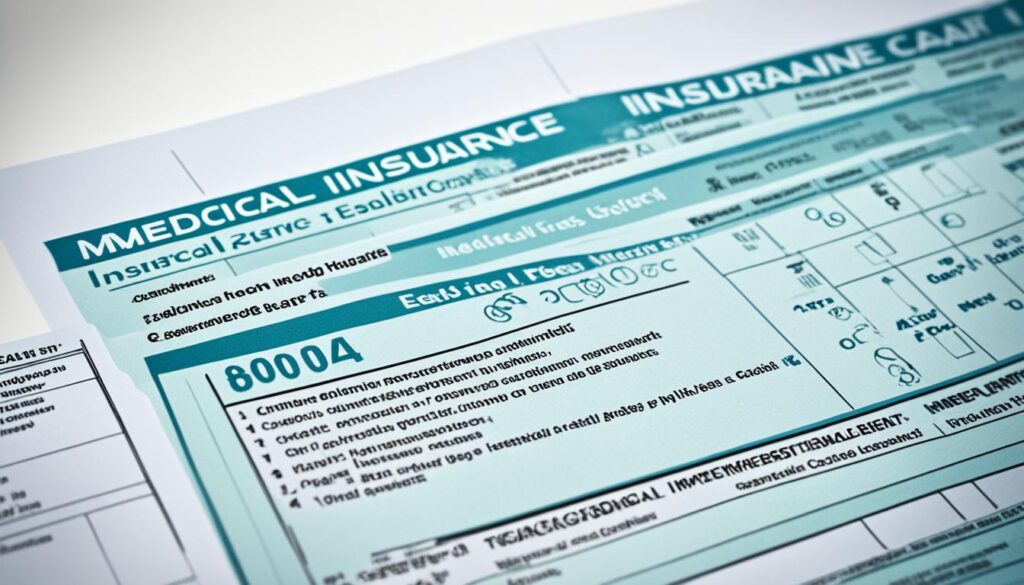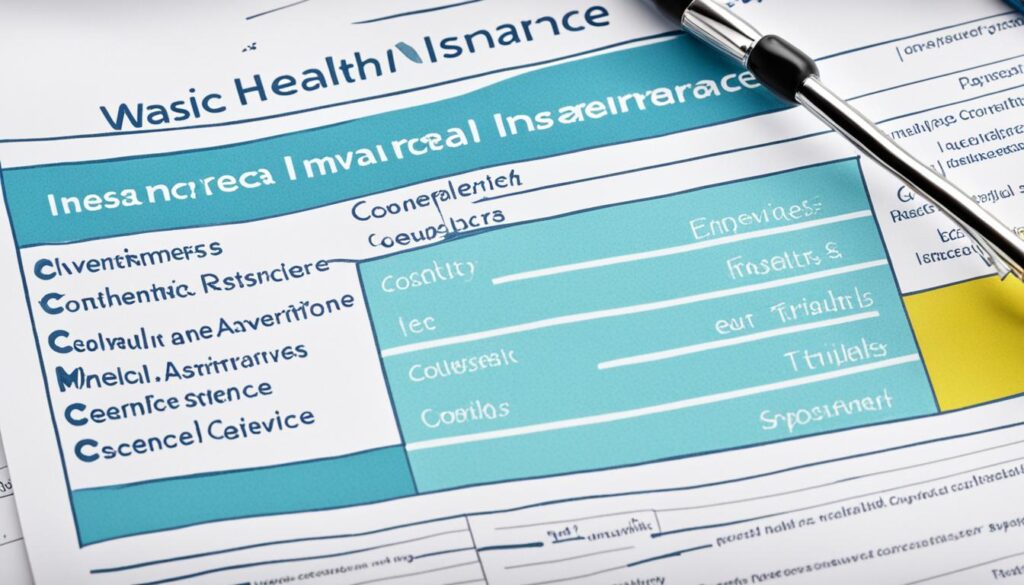Medical insurance is super important. It protects us from the big costs of getting medical help. It’s not just for when we’re sick or hurt. It also covers the check-ups, shots, and care that keep us healthy. But, choosing the right health insurance plan can be tough. There are many options, and what they cover can be very different from each other.
This piece is here to help you understand what a basic health insurance plan usually covers. We’ll talk about why health insurance is so crucial. And we’ll also look at how to pick the plan that best fits your needs. Knowing what’s in a health insurance plan lets you make smart choices. This way, you make sure you’re ready for any surprise medical costs.
Key Takeaways
- Medical insurance helps cover the costs of illness, injury, and regular healthcare services.
- Essential health benefits are a set of services that must be included in most health insurance plans.
- Preventive care, such as annual check-ups and screenings, is often covered at no cost to the policyholder.
- Mental health and substance abuse treatment are considered essential health benefits.
- Understanding the costs of health insurance, including premiums and deductibles, is crucial when selecting a plan.
Introduction to Health Insurance
In the United States, health insurance plays a key role in the healthcare system. It’s a deal between a person and an insurer. This deal helps with costs like doctor’s visits, hospital stays, and medicines. Knowing why health insurance benefits us is crucial for choosing the right plan for your healthcare needs.
Also Read : What Are The Different Types Of Medical Equipment Used In Hospitals?
What is Health Insurance?
Health insurance covers the medical costs of the person who is insured. It protects against high healthcare prices. With an insurance plan, people can get the medical help they need without worrying about very high costs. Plans can be different but aim to protect against big medical bills, especially from emergencies or long-term illnesses.
Importance of Health Insurance
Health insurance plays a vital role. It does a lot for us:
- Keeps us safe from huge medical costs if something unexpected happens.
- Allows us to get regular check-ups that can find health issues early, saving us money in the long run.
- Guarantees everyone can get needed healthcare, no matter their money situation.
- Gives peace of mind, knowing that our healthcare expenses will be helped some by the insurance.
By knowing the benefits of health insurance, people can pick the best plan. This ensures they’re covered well and can stay healthy.
Also Read : Medical Exam: How Do Doctors Perform A Thyroid Examination?
Essential Health Benefits

The Affordable Care Act (ACA) ensures that all qualified health plans cover essential health benefits. This means people have access to a wide range of medical services. It doesn’t matter what insurance plan they have.
Also Read : Medical Care: How Do We Choose The Best Medical?
Mandatory Coverage Requirements
Thanks to the ACA, health insurance has to cover specific essential health benefits. This includes things like outpatient care and prescription drugs. Also, it covers emergency services, maternity care, and mental health treatments.
Services Covered Under Essential Health Benefits
The ACA’s essential health benefits offer many medical services. These include hospital stays and outpatient visits. Also, they cover treatments for mental health, substance abuse, and prescription drugs.
- People get help with conditions that need a hospital stay.
- Outpatient care includes visits to the doctor and certain tests.
- Maternity and pediatric care are also part of this coverage.
- Mental health services involve both therapy and medicine.
- Help with prescription drugs is available for various conditions.
- Rehabilitation services support physical and mental recovery.
- Preventive care focuses on keeping people healthy with check-ups and shots.
The ACA requires these essential health services be covered. This ensures people have a full range of medical care. It works to keep everyone healthy and well.
Also Read : Medical Treatment: How Do Doctors Decide On The Best Treatment?
“The essential health benefits are designed to provide individuals with access to a wide range of medical services, ensuring that they can receive the care they need to maintain and improve their health.”
Preventive Care Coverage

Keeping healthy is a top goal for everyone. Health insurance is key in making sure people can get the care they need. Thanks to the Affordable Care Act, certain preventive care coverage and preventive services are free. This means you won’t have to pay for them.
Also Read : Medical Diagnosis: What Are The Steps In Diagnosing A Disease?
At no cost, you can get a lot of different services that help stop sickness or find health problems early. These include:
- Blood pressure and cholesterol tests
- Cancer screenings, like mammograms and colonoscopies
- Vaccines for adults and kids
- Counseling for things like smoking and drugs
- Special care for women, like check-ups and birth control
Getting these preventive care services for free means health insurance plans want you to be proactive. They help by offering check-ups and advice for better health. This early care can find and treat health issues sooner. This might lead to better health and less money spent on healthcare over time.
“Preventive care is an essential component of a comprehensive healthcare system, as it helps individuals maintain good health and prevent the onset of serious medical conditions.”
Adding preventive care coverage to health plans is vital for the whole community. It helps people stay well and eases the load on the health system. Making these services easy to get and affordable means everyone can work on their health and feel good.
Mental Health and Substance Abuse Coverage
Health insurance should cover mental health and substance abuse. In the US, insurance must include these services equally with physical health. This means people can get the proper care for their well-being.
The Mental Health Parity and Addiction Equity Act (MHPAEA) is important. It says insurance has to treat mental health and substance abuse like they do medical care. This helps people get the help they need without extra costs.
Services like inpatient and outpatient care, medication management, therapy, and recovery help must be covered. This makes care more accessible for everyone.
- Inpatient and outpatient mental health and substance abuse treatment
- Medication management for mental health and substance abuse conditions
- Behavioral therapy and counseling for mental health and substance abuse issues
- Rehabilitation and recovery services for substance abuse disorders
The act aims to stop the gap in how mental health and substance abuse are treated. By providing equal care, it fights the shame around these issues. It also encourages people to get help.
| Coverage Aspect | Mental Health and Substance Abuse | Physical Health |
|---|---|---|
| Annual or Lifetime Limits | No limits allowed | No limits allowed |
| Deductibles and Co-payments | Cannot be more restrictive than for physical health services | Cannot be more restrictive than for mental health and substance abuse services |
| Prior Authorization Requirements | Cannot be more restrictive than for physical health services | Cannot be more restrictive than for mental health and substance abuse services |
The MHPAEA fights for equal treatment between mental and physical health. It helps ensure people get the care they need without obstacles. This makes healthcare more complete for everyone.
“Mental health is just as important as physical health, and it’s time we treat it that way.”
Medical Insurance Costs

Finding your way through health insurance may seem hard. It’s tough to understand costs like monthly and out-of-pocket expenses. Knowing these helps you pick the best plan for you. Let’s look into what makes the cost of health insurance. This will help you choose wisely.
Premiums and Deductibles
The monthly premium is what you pay to keep your insurance. It changes based on the plan, your age, and where you live. Plans that cover more usually cost more. But, cheaper plans are out there.
Deductibles are crucial too. This is what you pay before your plan helps with costs. Some deductibles are low, like a few hundred dollars. Others can be high, up to thousands. With a bigger deductible, your monthly premium will be less.
Co-payments and Coinsurance
After the deductible, you might still share the cost. Co-payments are fixed costs you pay. This could be $25 to see a doctor. Or $10 for a medicine.
Coinsurance is a percentage you pay after your deductible. Say it’s 20% and a procedure costs $1,000. You’d pay $200 and your plan covers the rest.
| Medical Insurance Cost Component | Description |
|---|---|
| Premiums | The monthly fee paid to keep your health insurance. |
| Deductibles | The yearly out-of-pocket first amount before coverages start. |
| Co-payments | Fixed costs for certain healthcare services. |
| Coinsurance | The percentage of the total bill you pay after the deductible. |
Knowing these factors is key to picking the right insurance. It’s about balancing premiums, deductibles, and what you pay yourself. Making a smart choice ensures you get the coverage you need. And that you keep your costs in check.
Pre-existing Condition Coverage
The Affordable Care Act (ACA) has made big changes for people with pre-existing medical conditions. Before the ACA, insurance companies could say no or ask for more money because of pre-existing health issues. This made it hard for those with long-term illnesses or past health issues to afford good healthcare.
The ACA stopped this. Now, insurance companies can’t refuse coverage or make it more expensive because of someone’s health history. This includes conditions like diabetes, cancer, or heart disease.
The ACA’s new rules have been key in making sure all Americans get the support they need. This change is a safety blanket for the many who struggled to get or keep health insurance because of past health issues.
Besides this, the ACA requires insurers to offer wide-ranging coverage. This includes care for pre-existing conditions. So, people with such conditions can get the treatments and drugs they need without huge costs.
Overall, the ACA’s steps on pre-existing conditions are huge for healthcare. They’re making sure everyone gets the care they need, no matter their past health.
| Pre-ACA | Post-ACA |
|---|---|
| Health insurers could deny coverage or charge higher premiums based on pre-existing conditions | Health insurers are prohibited from denying coverage or charging higher premiums based on pre-existing conditions |
| Individuals with pre-existing conditions often struggled to obtain or maintain health insurance | Individuals with pre-existing conditions are guaranteed access to comprehensive health insurance coverage |
| Pre-existing conditions were a significant barrier to healthcare access | Pre-existing conditions are now covered under essential health benefits, ensuring access to necessary treatments and medications |
The ACA has been vital for those with pre-existing conditions. It has drastically improved healthcare for many in the US. By stopping insurers from saying no or asking for more based on health history, the ACA ensures coverage is available. It does this without the worry of rejection or huge expenses.
What Medical Insurance Does Not Cover

Health insurance plans cover many medical services. But, some treatments and procedures aren’t part of the basic coverage. It’s important to know what’s not covered when picking or using a health insurance plan.
Cosmetic Procedures
Health insurance doesn’t usually cover cosmetic procedures. These treatments aim to make someone look better, not fix a medical issue. For instance, breast augmentation, tummy tucks, and nose jobs aren’t covered normally. However, if it’s needed for a medical reason, such as surgery after an accident, insurance might cover it.
Fertility Treatments
Fertility treatments like IVF and artificial insemination aren’t often covered by insurance. Some plans offer a little help for fertility treatments, but they come with restrictions. Those wanting these services might need to get special fertility coverage.
| Excluded Services | Potential Coverage |
|---|---|
| Cosmetic procedures (e.g., breast augmentation, tummy tucks) | May be covered if deemed medically necessary (e.g., reconstructive surgery after mastectomy) |
| Fertility treatments (e.g., IVF, artificial insemination) | Some plans may offer limited fertility benefits, but coverage is often restricted |
It’s crucial for people to review their health insurance carefully. They should understand what services and treatments aren’t covered. This knowledge helps them prepare for any costs they might have to pay.
“Understanding the exclusions and limitations of your health insurance plan is crucial to managing your healthcare costs effectively.”
Choosing the Right Medical Insurance Plan

Choosing a medical insurance plan, though tough, is crucial. It really affects your money and how easily you can get healthcare. When choosing health insurance or selecting a health plan, you must think about many things. This ensures you pick a plan that suits your needs and budget.
The monthly premium is a key element. This is what you pay to keep the insurance going. You should also know about the deductible. It’s what you have to pay first, before the insurance helps. Think about co-payments and co-insurance too. These are costs you share with your insurance company.
Looking at what the plan covers is very important. Check that you can go to your top choice for healthcare. This means seeing if your favorite doctors, specialists, and hospitals are included. Make sure the plan also helps with any health issues you had before. This can affect how much you pay and the care you can get.
It’s smart to look at plans from different places. This includes options from your job, the marketplace, or private companies. Comparing helps you find what fits you best. It makes sure you’re prepared for health surprises or if you have ongoing health needs.
| Factor | Importance |
|---|---|
| Monthly Premium | The amount you pay to maintain your insurance coverage. |
| Deductible | The amount you must pay out-of-pocket before your insurance coverage kicks in. |
| Co-payments and Co-insurance | The shared costs between you and your insurance provider. |
| Covered Services | Ensure the plan includes access to your preferred healthcare providers and covers any pre-existing conditions. |
Think through these points carefully when evaluating health insurance options. This helps you pick a medical insurance plan that really meets your healthcare and money needs.
Medical Insurance and Healthcare Reform
The Affordable Care Act (ACA), known as Obamacare, changed healthcare in the U.S. This 2010 law aimed to make health insurance more affordable and improve its quality. It introduced the individual mandate. This rule said most people must have health insurance or pay a tax. Also, it set up marketplaces where people could buy health insurance.
Medicaid, the program for low-income people, was also made bigger. The ACA let states offer Medicaid to more people. This move has helped millions get better access to healthcare. The ACA added rules for health insurance too. It made sure that plans covered basic services. Plus, it stopped companies from not covering sick people.
Since 2010, the ACA has faced many challenges. Yet, it has changed healthcare in the U.S. It’s important for everyone to know their health insurance rights and options.
| Key Provisions of the Affordable Care Act (ACA) | Impact |
|---|---|
| Individual Mandate | Increased the number of individuals with health insurance coverage |
| Medicaid Expansion | Improved access to healthcare for low-income individuals |
| Essential Health Benefits | Ensured comprehensive medical coverage for individuals |
| Pre-existing Condition Coverage | Prohibited insurers from denying coverage based on pre-existing conditions |
The Affordable Care Act (ACA) reshaped healthcare in the U.S. It introduced new rules and made insurance more available. Its effects are still felt today.
Resources and Support

Navigating the world of health insurance is complex. But, support is available through state and federal agencies. Online tools and resources also provide guidance. These help users understand their options, file complaints, and make informed decisions on health insurance.
State and Federal Agencies
The Centers for Medicare & Medicaid Services (CMS) and the Department of Health and Human Services (HHS) are key. They oversee U.S. health insurance programs. Their websites offer lots of info on Healthcare reform, Medicare, Medicaid, and more.
Each state’s insurance department oversees health insurance locally. They assist with complaints, knowing your rights, and finding health insurance resources.
Online Tools and Resources
- Healthcare.gov is a go-to for the Affordable Care Act, health insurance marketplaces, and choosing plans.
- States and communities often have insurance counseling. These services are free or low-cost and help with health insurance navigation, including choosing and enrolling in a plan.
- eHealthInsurance.com and HealthCare.com let you compare health insurance plans. This is based on what you need and budget.
By using these health insurance resources, government agencies, and online tools, consumers can better understand their health insurance options. They can make more informed choices about their coverage.
Also Read: What Are The Future Trends In Medical Technology?
Conclusion
Basic medical insurance covers many key health services. This includes hospital stays, doctor visits, and mental health care. It’s important to know what your health insurance plan offers, including costs and coverage.
The Affordable Care Act has made it easier for many people to get health insurance. Now, having a pre-existing condition or low income doesn’t stop you from getting covered. Remember, it’s smart to look closely at different insurance options to pick the best one for you.
Being aware of your health insurance’s details can help you make better choices. It lets you understand the healthcare system better and protect your health. Stay informed about your coverage and the help available to you.
FAQs
What is health insurance?
Health insurance is like a deal between you and a company. This deal helps pay for your medical costs. It covers things like seeing the doctor, staying in a hospital, and buying medicine.
Why is health insurance important?
Health insurance is key because it stops you from worrying about big medical bills. It also lets you do regular check-ups to stay healthy. Plus, it makes sure you get the care you need when you’re sick.
What are the essential health benefits that must be covered by health insurance plans?
The Affordable Care Act says health insurance must include important services. It covers things like hospital stays, emergency care, and mental health support. It also helps with check-ups, prescriptions, and caring for babies.
What preventive services must be covered by health insurance plans?
Your health insurance must pay for specific check-ups and shots. This is to keep you healthy and safe. It includes tests for things like high blood pressure and cancer.
How must mental health and substance abuse services be covered by health insurance plans?
Insurance in the U.S. must treat mental health and drug use help the same as regular physical care. This stops unfair limits or high bills for mental health care and addiction help.
What are the main components of the cost of medical insurance?
The first part of the cost is the premium you pay every month. Then, there’s the deductible you cover yourself each year. After that, you might pay a small amount for each visit called a copayment. Or you share the cost with the insurance, which is coinsurance.
Can health insurance companies deny coverage or charge higher premiums based on pre-existing medical conditions?
No, they can’t turn you away or make you pay more because of past health problems. The law, called the Affordable Care Act, stops this unfair practice.
What types of treatments and procedures are typically not covered by health insurance plans?
Insurance usually won’t pay for things that only make you look better. Treatments like in vitro fertilization might also not be covered, unless your plan specifically says it does.
What factors should be considered when choosing a medical insurance plan?
Think about how much you will pay each month as the premium. Also, consider the deductible and any extra costs like copayments. Look into what the plan covers and if your favorite doctors are included. Don’t forget to check if it helps with your existing health issues.
How has the Affordable Care Act (ACA) impacted the health insurance landscape in the United States?
The ACA, or Obamacare, made health insurance better in several ways. It requires almost everyone to have coverage. It created places where you can easily compare and buy plans. Plus, it let more people join Medicaid, making health insurance more affordable and complete.
Where can individuals find support and information on health insurance?
For help and advice on health insurance, visit the Centers for Medicare & Medicaid Services (CMS) or the Department of Health and Human Services (HHS). Your local state insurance department can also help. Online, Healthcare.gov and local counseling services offer info on choosing a plan, options, and how to complain or ask for help.
